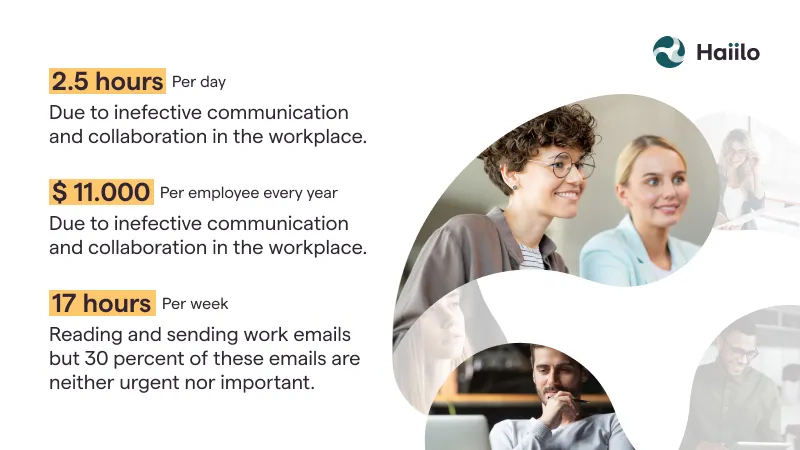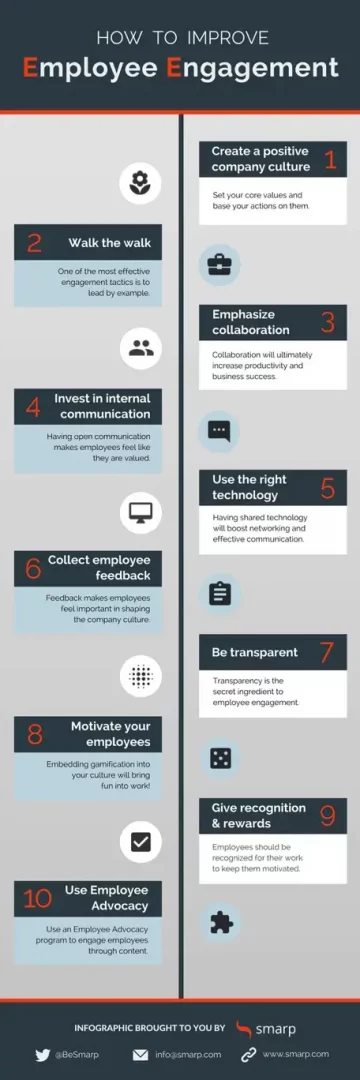We share in this blog post 5 internal communications best practices that will help you align your employees’ personal goals with the company’s vision.
In most businesses, not all employees know where the company is heading.
74% of employees have the feeling they are missing out on important information at work. What’s more, most of them don’t have a clear understanding of the company’s vision and long-term goals.
📚 Check out our article about Communication Strategies and How to Build Your Own!
Your internal communications have a great impact on the way your employees perceive your business.

Building an effective internal communications strategy will help you create synergy across your organization. It’s the only way you can create a sense of commitment toward common goals.
When your employees have a good understanding of your vision, strategic goals and company culture, they are more likely to take your business to the next level.
However, many companies are facing a challenge that slows down their growth: misalignment with the company’s core values and goals.
Help your employees align their personal goals with business goals by using the right communication tools
Building an effective internal communications strategy will help you create synergy across your organization. It’s the only way you can create a sense of commitment toward common goals.
When your employees have a good understanding of your vision, strategic goals and company culture, they are more likely to take your business to the next level.
However, many companies are facing a challenge that slows down their growth: misalignment with the company’s core values and goals.
Ensuring that your employees believe in your business and work toward a common goal is essential. Overall, it’s your business’s success that may suffer from a lack of alignment between your organization and your employees.
Broadly speaking, misalignment in the workplace is strongly connected with:
- A lack of motivation
- Misunderstanding of the business goals
- Lower employee productivity
- Barriers to project management
- Lower team performance
- Misinformation in the workplace
- Confusion among employees
- Organizational silos
- Duplicate work
- Missed targets
- A poor employee experience
- Barriers to employee empowerment
- Lower employee engagement
- Lower retention rates
- Difficulties to attract top talent
Even though internal communications have a direct impact on the business’s bottom line, 60% of companies are still missing a long-term strategy for their internal communications.
What’s more, most of them don’t have a solid internal communications plan in place to align their employees with their business goals.
It’s now time to take action!
We share below 5 steps to improve alignment across the organization.
But before going through the strategy that will help you ensure that everyone is on the same page, let’s deep dive into organizational alignment and the impacts on the business.
What Is Organizational Alignment?
Organizational alignment is a process of ensuring that the entire workforce understands, shares and supports the company’s vision and goals.
When employees are aligned with the company’s strategic goals, they give their best performance to achieve business goals together.
As a result, they feel motivated and inspired to go the extra mile for your business.

There are actually 4 levels of alignment you need to maintain in your organization to build a successful business:
- Employee-role alignment is all about finding the right fit for the position at hand. You’ll need to have the right talent in house so you can drive synergy and get your employees’ buy-in.
- Employee-goal alignment. To get your employees moving in the same direction, you’ll need to make sure their personal goals or targets are aligned with the business goals overall. The key here is to set specific and measurable goals for your employees.
- Employee-team alignment. Your employees need to effectively combine their expertises and strengths so they can contribute to the team’s success. You’ll need to encourage them to better synchronize their efforts and you’ll also need to improve communication between managers and their teams.
- Employee-organization alignment is the final level of alignment in the workplace. Employee-organization alignment happens when the employees have a great understanding of the company as a whole: its strategy, culture, mission, short and long-term goals. This level of alignment is strongly connected with the level of commitment of your employees and how successful your business is.

But aligning employees with the company’s vision and goals doesn’t come easy.
It takes time and effort to actually encourage employees to work toward a common goal.
Don’t worry, we’re here to help!
We share below our top 5 internal communications best practices for ensuring that your employees are aligned with your company’s goals and mission.
5 Internal Communications Practices for Aligning Your Employees with Your Strategic Goals
95% of employees do not fully understand the company’s goals or what is expected from them to achieve these goals.
This stat is choking and alarming, isn’t it?
One of the main reasons why employees don’t fully understand the company’s goals is because these goals are not clearly communicated and explained to them.

Put differently, this lack of alignment across the organization is due to poor internal communications. Indeed, 60% of companies don’t have a long-term strategy for their internal communications.
Now, the question is: how do you effectively communicate the company’s goals, values and mission to your entire workforce?
Related: Company Values: Definition, Importance and Examples
We share below internal communications best practices that will help you improve alignment at your workplace:
1. Assess Your Current Internal Communications Plan
If your pulse surveys show that your employees don’t have a full understanding of what your strategic goals are, start assessing your current internal communications strategy. Indeed, internal communications turn out to be one of the main reasons why organizations and employees are not aligned.
More specifically, start evaluating the channels you’re currently using to communicate your business goals and mission to your employees.
For example, maybe you’re organizing meetings or workshops where your employees learn more about your strategic goals.
But this method is complicated to implement in large organizations with thousands of employees.
How can you actually make sure that all your employees — either we’re talking about 10,000, 20,000, 50,000 or even more employees — are able to attend face-to-face meetings or workshops on the company’s goals, business model and vision?
That’s almost impossible.
Alternatively, you may want to explain your strategic goals in a newsletter that you would send to your employees every month or every quarter.
But let’s be honest here — who does really pay attention to standardized email newsletters?
They are usually not that engaging, and they tend to go unread in overwhelming inboxes.
The average office worker receives 121 emails per day and 62% of these emails are not important.

It looks like sending out email newsletters to your employees isn’t the best option to communicate your business goals internally!
Instead, you may want to tailor your newsletters based on your employees’ needs or you may want to use other types of content. For instance, videos or podcasts drive more engagement!
Related: 14 Internal Communication Experts Share Their Top Priorities
2. Use the Right Channels for Your Internal Communications
To create a better synergy at your workplace, you’ll need to make sure that you communicate your strategic goals to all your employees.
In most companies, strategic goals are discussed with the board, top management and middle management, but they are usually not explained to the employees.
Poor internal communications are connected with lower employee motivation and productivity in the workplace.

To actually communicate your company’s goals and strategy to your employees in an effective way, you’ll need to use a channel that allows you to reach your entire workforce — a digital channel.
Using digital channel for your internal communications, such as an employee communication platform, is one of the best ways to connect your employees, no matter where they are located.
To make sure that your employees are aligned with your company’s vision and goals, use your employee communication platform to share key information such as:
- Company updates
- Product updates
- Business results
- Updates on your competitive analysis
- Educational materials such as tutorials
- Meeting recordings
- Webinars and podcasts
- Marketing materials such as videos, eBooks and success stories
The trick here is to use a mobile-first employee communication platform so you can reach all your employees, office-based and remote.
Think about: not all of your employees have a company laptop. Some of them may even not have a work email address! However, they have a smartphone. And one of the first things we do while we’re commuting is checking our phones to catch up with the latest news, chat with your friends and check the latest work-related information we’ve received.
If you communicate your business goals through a channel that helps you reach all your employees, you’ll considerably improve your internal communications all while ensuring that everyone is on the same page!
3. Simplify and Centralize Your Message
Reading long reports is not that fun, right? And your employees probably won’t have time for that.
If you want your employees to keep up with your strategic goals and vision, you’ll need to find new ways to communicate them internally.
Videos, short posts, podcasts or infographics will help your employees keep up with your goals and objectives.
For instance, top management can explain business goals and where the company is heading in a series of short videos that they would share through your employee communication platform on a weekly or monthly basis, depending on the goals the company wants to achieve and how complex they are.
Top management can also write short posts or create infographics where they would highlight the important changes the company is undergoing.
90% of the information processed by the brain is visual. What’s more, the human brain processes images 60,000 times faster than text, so let’s take advantage of visual content!
Related: Sara McGuire on Why Visual Storytelling Drives Higher Engagement
Creating different kinds of content to communicate your strategic goals to your employees is a great way to drive engagement.
But the key here is to centralize all your content into one place, so your employees don’t spend time looking for it. That’s what employee communication platforms are made for!
4. Customize Your Internal Communications to Drive Employee Engagement
Sharing standardized information to your entire workforce is not the best way to actually align your employees with your business goals and vision!
You don’t want your employees to feel overwhelmed by information overload, do you?
The information you share and the way you share it have a direct impact on the employee engagement you’re able to drive.

Related: 8 Employee Engagement Statistics You Need to Know in 2020
To help your employees keep up with the company vision and feel engaged, make sure you customize the information you share to your employees and the way to share it.
For example, some of your business goals may have a strong impact on your tech team and less impact on your operations team. Others may require a strong collaboration between your marketing and sales team.
That doesn’t mean you’re going to communicate your business goals to some of your teams only. You don’t want a part of your employees feel disconnected, right?
Instead, you’re going to customize the way you communicate your messages to your employees.
Related: How Your Internal Communications Can Boost Employee Engagement at Your Workplace
One of the best ways to do so is to segment the content you share internally based on your employees’ roles within the organization, their location and the language(s) they speak.
For example, you can create groups and channels on your employee communication platform your employees can subscribe to so they receive in their newsfeed the information they need, nothing else. It’s that simple!
The key is to keep in mind that employees are dealing with information overload every day. Remember that employees spend 2.5 hours per day looking for the information they need to do their jobs!
Segmenting the content you share internally and personalizing the messages you share with your employees is one the the best ways to support your employees!
5. Encourage Your Employees to Play an Active Role in Your Internal Communications
It can be frustrating for employees to receive information and updates on the business goals on a regular basis without having a chance to take part in the discussion.
Encourage your employees to react to and comment on the content you share with them. Let them ask questions and even start discussions around your business!
Most importantly, use your employee communication platform to centralize all these discussions around your business goals, missions and core values.
That way, even your employees that don’t actively take part in the discussions can easily keep up with what’s happening in the organization.
Encouraging your employees to be part of the discussion is also a great way to collect feedback.
It will also help you see how employees react to it and what adjustments you may need to make in terms of communications and brand messaging.










